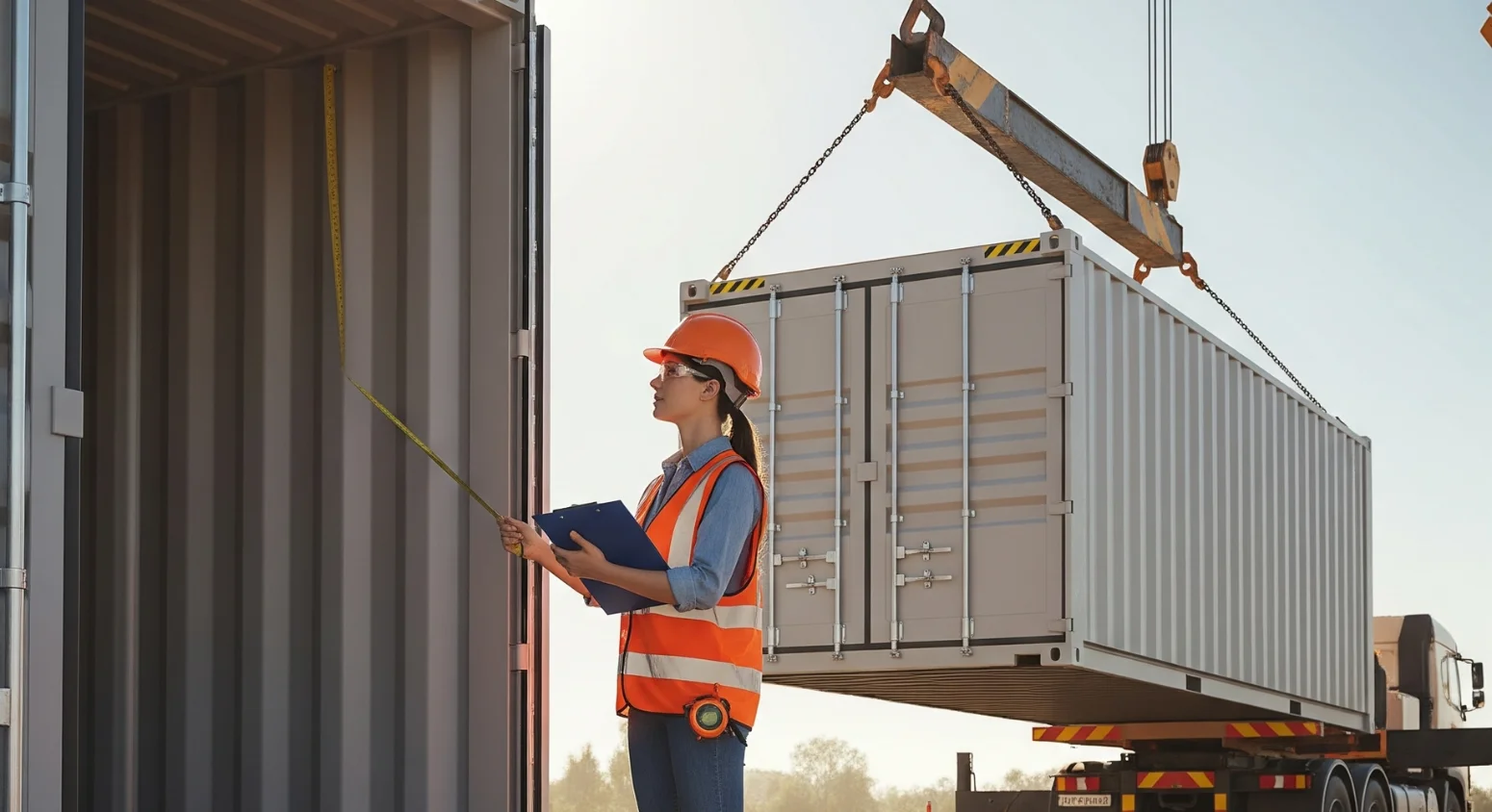Efficient movement of shipping containers is important if you are either operating a warehouse or transferring long distances. You may be surprised, but the right equipment makes all the difference – in this case, the dolly for shipping containers. From a container dolly to the heavy-duty model with pneumatic casters, the right tool will make it easier to move, safer, and less likely to be damaged at certain points.
In this post, we’ll explore tips to optimize your long-distance container moves. Discover how the right dolly, combined with effective planning and safety measures, can streamline your operations and save time. Let’s dive in and make your container handling more efficient!
Table of Contents
1. Understanding Long-Distance Container Moves
Long-distance moves using shipping containers are pretty complicated, involving much planning, proper equipment, and strategy. What then is different in these long-distance moves? Let’s see what is special.
1.1 What is So Different About Long-Distance Moves?
Therefore, issues related to terrain and weight will be critical in shifting shipping containers long distances. And so an efficient transport system will be needed as well. For instance, where short distances only require meters of shift, long distances would require covering vast spaces over rough or uneven surfaces. In this case, your equipment has to be up for the task.
For example, a container dolly with heavy-duty pneumatic casters is ideal for long distances. These casters provide the stability and durability needed to move heavy containers without worrying about damage to either the container or the ground surface.
1.2 Common Challenges of Long-Distance Moves
Here are a few challenges you’ll likely face during a long-distance container move:
- Harsh Topography: A tract of broken ground or a wilderness will challenge standard equipment. A shipping container dolly fitted with heavy-duty pneumatic casters may roll across a driveway of gravel or dirt without any problems.
- Weight Disbursal: Shipping containers are heavy and you need the right equipment to carry the weight evenly. Uneven weight can cause serious problems like tipping or instability. When the load is unevenly distributed the center of gravity shifts and the whole thing can topple over especially during sharp turns or on uneven terrain. This not only puts the products in danger but also the people around the area. Balanced weight distribution prevents this risk by keeping stability and evenness in motion even in a difficult situation.
- Time Constraints: Long-distance relocation is usually a time-consuming activity. Inability to get the right equipment may cause inefficiency that results in delayed moving. Saving time may be achieved by using a good long-distance container dolly, as it allows mobility and prevents accidents.
1.3 Pre-Move Cross-Country Move Precautions
Before beginning your cross-country relocation, consider the following:
- Route Planning: As in every other long-distance travel, plan ahead. First and foremost, determine if the route you choose is free of obstacles and if the terrain can support the weight of your container and equipment.
- Choose the Right Equipment: Having the right dolly for shipping containers is essential. Choose a dolly that fits the container size and weight and is equipped to handle the terrain you’ll be crossing. Heavy-duty pneumatic casters on your dolly will help make the journey smoother.
- Safety First: Long-distance moves can be hazardous, especially if the equipment is not up for the challenge. Invest in a high-quality, sturdy container dolly and ensure your team is well-trained in its use.
1.4 Why Equipment Matters
Equipment is everything when it comes to long-distance moves. The difference between an easy and efficient move and a frustrating one can be determined by using a container dolly designed for heavy loads. The fact is that it’s all about finding the right support from both containers and operators. Well-built casters ensure that the heaviest containers can be transferred with long distances without straining it or the ground surface.
2. Choosing the Appropriate Equipment to Move Shipping Containers
When a long distance must be covered over shipping containers, it is worth noting that, sometimes, how well you go about the activity is determined by the equipment at your disposal. Today, however, there are thousands of options as to which ones you should make use of when shipping containers around. Let us first categorize and tell you what should be looked at in the correct choice of a suitable equipment.
2.1 Significance of Load Capacity and Durability
To begin with, your equipment has to be strong enough to bear the weight of your containers. Shipping containers are very heavy and sometimes weigh a thousand pounds. You require a dolly for shipping containers that is robust enough to hold such loads without losing its stability or compromising on safety.
It is vital to find equipment with a high load capacity, well constructed to take on the pressure. A sturdy construction for your container dolly ensures a hassle-free move with heavy or bulk containers.
Durability in the wheels is another good point. Heavy-duty pneumatic casters are good for long-distance moves. They are built to withstand heavy loads and uneven surfaces that will enhance maneuverability as well as reduce the stress on your equipment.
2.2 Best Equipment for Long-Distance Moves
Not all dollies are the same, and based on your requirements, some might be better for long-distance container moves than others. Some of the most common types of equipment include the following:
- Container Dollies: These are used primarily for moving containers and provide good weight distribution as well as ease of movement. In choosing a container dolly, pneumatic wheels are a good feature for added traction and durability over distance.
- LiftWich: LiftWich is primarily designed as a highway dolly, tailored for long-distance transportation. It supports higher speeds and offers reduced carbon emissions, making it ideal for efficient and eco-friendly container movement over long distances
- Tow Bars and Hitch Systems: To tow containers over very long distances, you might need a shipping container tow bar or a shipping container hitch. These towing accessories are attached to containers so that they can be towed by a vehicle for long-haul relocations.
2.3 Why the AnyWich is Perfect for Long-Distance Moves
If you’re looking for the ultimate solution for long-distance container moves, look no further than the AnyWich. This piece of equipment is designed to carry up to 40,000 lbs of weight while still being lightweight and easy to maneuver.
It’s designed with heavy-duty pneumatic casters to ensure a smooth, controlled move even on the roughest terrains. Besides, its compact size and efficient design make it perfect for tight spaces or busy work areas, making it pretty versatile.
2.4 Additional Equipment You Might Need
Sometimes, moving long distances requires tools beyond a simple dolly to move the shipping container. More tools can maximize your move like this:
- Tow Hitch of Shipping Container: This is also used to secure the container against a vehicle to take it long. It is preferably used for moves in the yard where you have huge distances to drive between containers for towing.
- Cranes: If you have to put containers on the vehicle for an overland journey, cranes are a blessing. They will help you to transfer heavy containers onto trucks or other transport vehicles.
- Flatbed Trailers: For very long distances, the best way to secure containers is by using flatbed trailers that can ensure safe long-distance transportation.
3. Pre-Relocation Preparations: Fast Long Distance Container Move
When discussing a long distance container move, one golden rule is produced: it is all about planning. The more you plan, the better it is that you will have an efficient and safe movement. So, what do you do to prepare in order to achieve efficiency and safety? Well, here is how to map out the right steps for preparation in preparing your move.
3.1 Route Planning: Obstacles and Detours
This journey over the highway with a trailer load of container haul begins from planning the routes. Do you pass over a hyper warehouse or just go through some construction zone? Are you out there in the sticks working with rough roads? That notwithstanding, what matters is your research and making all the decision of the ground your containers pass over.
And in planning ahead for your routes, here’s what you might consider, among others:
- There shouldn’t be any kind of obstruction in the way. Any type of debris, machinery, etc will cause delay in the work. Clear all the pathways, so smooth working is achieved.
- Terraine evaluation: Should the movement require gravel or soil or rough surface, then there is a need to have excellent applied equipment for such territory. In case of application of a container dolly, heavy-duty pneumatic casters would be recommended.
- Take into consideration the flow of Traffic. When traffic is heavy, make sure the movement does not interrupt other things going on there. A well-planned and safe path makes such hassles less inevitable.
3.2 Pre-shifting preparation of containers
It must be prepared inside the container before shifting. Safe making of a container will make a human lose not only his possession but more than that, their actions won’t hurt the thing that they hate to be happened. Among others, there is this :
- Checking the Container: To move, someone has to find some damages or issues before taking them along. It saves valuable time that something else can pop out during transport time.
- Secure Content: Make sure the contents of the shipping container are secured to prevent movement or rattling during transit. This means using the right strapping, supports and padding to stabilise items in the container. For categorisation and extra safety make sure all strapping materials meet industry standards and are suitable for the weight and type of cargo. Also consider using anti slip mats or dunnage bags to secure items and prevent movement during sudden stops or vibrations.
- Seal Container: Sealing the container is critical to prevent tampering, spillage or loss of contents during transit. Use ISO compliant container seals such as bolt or cable seals which provide a tamper evident locking mechanism. These seals secure the cargo and meet international shipping regulations. Before sealing check the integrity of the container doors and locks to ensure a good seal, to prevent water or debris from getting in during transit.
3.3 Timing in Scheduling and Logistics
As your case goes by scheduling, timing really matters in how your container move will end up. In terms of determining your schedule consider these points below:
- Peak Hours: Plan your move time to be when there is no heavy traffic or other activities in the area, which might delay your plan. In fact, early morning or late afternoon would be good times to set.
- Weather Conditions: The weather might play another critical role in your move. As much as possible, avoid moving your containers during extreme weather, say during rain or snow which might compromise the stability of your dolly, or that of the terrain.
- Team Coordination: Ensure your team is in sync, and each person is perfectly aware of what they have to do. All of it moves flawlessly with appropriate communication.
3.4 The Right Dolly for Shipping Containers
It all matters a great deal when picking the right dolly for shipping containers as that guarantees everything would move smoothly. Consider the following in that regard
- Weight Capacity: The equipment you are going to choose must have the weight-carrying capacity of the container and its contents. Ensure that the container dolly has enough weight capacity.
- Manoeuvrability: All the equipment you are going to need must maneuver easily over the whole route. While working in tight areas or uneven terrains, the pneumatic casters will give you much more control and flexibility with your equipment.
- Durability: This would require durability in such equipment, so that it does not fail when reused several times for long movements. Heavy-duty pneumatic casters are suggested for support through heavy loads over a long distance.
4. Safety of Long Distance Container Moving
Long distance container moves require the greatest care with respect to safety factors. Be it a heavy piece of machinery or moving a shipping container over some bumpy grounds, it would only be practical to ensure the safety of all and prevent accidents which cost one a good deal of money. How does one do that, though? Dive in with the must-haves on the safety list.
4.1 Assessing the Site Before Moving
Before even thinking about moving a container, it’s important to assess the environment where you’ll be working. Are there uneven surfaces, tight corners, or other hazards that could pose risks? Taking the time to inspect your site can save a lot of time—and prevent dangerous situations.
Here’s a checklist for assessing your move site:
- Examine Ground Stability: Check that the ground is stable and firm enough to support the shipping container dolly and also the shipping container. Avoid areas that have loose gravel or sand.
- Clear Obstacles: Eliminate debris, tools, or equipment that could be in the area to impede the movement of the shipping container. Sufficient space needs to be allowed to maneuver the equipment safely.
- Check Lighting: If a move is to be undertaken in low light conditions, the venue should be made bright to assist your crew view possible dangers vividly.
4.2 Securing the Container and Equipment
After you have determined your site, the next thing is ensuring you secure both the container and your equipment so accidents do not take place when your move.
- Lock the Container: Lock the container before moving it. Lock it down to the container dolly with a lock, so it doesn’t move on the road.
- Use Proper Strapping: When the items are not well-arranged, ensure that strapping or tie-downs are used. It is significant when one has items to be moved, and the contents inside the container tend to shift about when being moved.
- Check Equipment Integrity: Inspect the container dolly for wear or damage before moving. The heavy-duty pneumatic casters are a critical component to maintain control of the move, so ensure these are in good condition.
4.3 Team Communication and Coordination
Moving containers is a great group activity because moving requires the best communication for the perfect move. It involves much coordination with your team in moving heavy and large bulky items across a long distance and should be devoid of errors or accidents.
Best Practices for Effective Team Communication:
- Clearly Define Roles: Everybody must know what everyone’s job is in the process, be it guiding the dolly or keeping track of the position of the container.
- Hand Signals: If noisiness is high or it’s necessary to communicate over long distances, hand signals can be as simple and easy as getting through to people’s minds in one shot.
- Stay in Constant Contact: Communication lines should never go dark; if anything goes wrong, your team can react quickly to solve the problem.
4.4 Weather Monitoring
Weather can be an important factor in making your move safe and easy, especially for long-distance transportation. Take care to monitor weather conditions ahead of time and adjust your plans if the need arises.
- Avoid Moving in Extreme Weather: If it is raining, snowing, or very windy, then postpone the move. Wet or icy conditions can make surfaces slippery and increase the risk of accidents.
- Monitor Wind Conditions: Strong winds can destabilize containers and make them hard to move. Ensure the forecast is clear before proceeding with the move.
4.5 Using the Right Equipment for Control
This is because you will be in control of the container when using the right equipment, and accidents are therefore prevented, and the whole process becomes much smoother. The container dolly with heavy-duty pneumatic casters offers great stability and maneuverability, especially when operating on uneven terrain or rough surfaces.
- AnyWich: It is very good equipment and designed for controlling heavy loads efficiently. With this, its toughness and lightweight structures make the containers even the heaviest so easy to maneuver while giving safe and stable security for long distances.
5. Last-Minute Tips for a Smooth Long-Distance Container Move
You’re prepared, planned, and secure, but what’s the formula to make sure your move goes as smooth as it gets? You’ll have the right equipment and procedures in place, but what little extras ensure that your container moves with no troubles you might not have thought of?
5.1 Flexibility: Roll with the Punches
Even the best-planned move is not immune to mishaps. From a sudden change in weather, an obstruction on the path that one hadn’t seen, or last-minute changes in plans, the flexible always ensure that things do not go off course.
Here’s a little something to remember:
- Adapt to Delays: Some outer factors, which may not have been expected before the moving, may include some traffic or an unexpected event related to the process. This automatically means one would have to make adjustments to time allocated in getting results that one would consider satisfying after the movement.
- Plan for Emergencies: It is important to have another plan that may be used at any time there could be an emergency about primary equipment malfunction or an event with the container.
5.2. Timing the Optimization
Timing is everything in managing long-distance container moves. Moving at the right times will save your team from unnecessary congestion or adverse weather conditions.
Timing tips to optimize a move are as follows
- Choose off-peak hours; mostly your team prefers early mornings or late afternoons, which rarely have any congestion and can help your team make the most out of daylight.
- Remember to keep the weather in mind: Plan your move when the weather is calm. Rain, snow, or even intense heat can make the move more difficult and potentially damage the container or equipment.
5.3 Right Equipment for Each Job
You have done the hard work in picking a good quality machine, but what will get you to really enjoy your efficiency will be choosing the right dolly for shipping containers. AnyWich: The Machine Dolly is a good maneuverable and heavy load moving dolly with heavy-duty pneumatic casters that minimize friction and move the dolly easily on the ground. The machine is very light, and you will easily set it up and begin to move it within a few minutes.
To get maximum efficiency, ensure that all the equipment is in the following state:
- Well-Kept: All equipment must be checked before the move. Ensure that all of this equipment is in its best state and do not use any equipment which may delay due to worn-out parts.
- Good for the Ground: Container dolly wheels must be appropriate to the ground, regardless of it being smooth concrete or even rough gravel. For rough surfaces, pneumatic wheels will be appropriate. For smoother paths, solid rubber wheels will do.
5.4 Record the Process for Future Moves
- Record everything: If this is part of a bigger project or a series of container moves, you can improve on documenting the entire process in future moves. You can do this by keeping very detailed notes so you know what works and what does not so you can streamline your processes moving forward.
What to record:
- Equipment Performance: Mark how well your equipment performed during the move. Was the dolly for shipping containers strong enough? Were there maneuverability issues?
- Timing and Scheduling: Identify when it was easy to move the containers and what should be avoided to ensure timely movement.
- Lessons Learnt: With each move, one learns. Document challenges experienced and how you surmounted them for improved future movements.
Conclusion
Perhaps long distance moving of container had been executed through proper planning, proper equipment, and proper safety. Flexibility and time optimization is possible especially when you are sure of having effective tools like AnyWich, with heavy-duty pneumatic casters, making it assured to have a smooth and problem-free move. When you arm the said skills on challenges, nothing will pull you wrong.
FAQs
1. What are the best options for equipment in moving shipping containers long distances?
AnyWich: The Machine Dolly is an excellent choice for long-distance moves because it has great maneuverability, light design, and heavy-duty pneumatic casters that can handle rough terrain.
2. How do I keep my shipping container safe during a move?
Additional tie-downs or strapping will prove sufficient in securing the shipping container properly onto the shipping container dolly for inside security. Good communication assures also clearance of obstacles and hazards as well as teamwork.
3. What are the benefits of pneumatic casters on shipping container moves?
Pneumatic casters provide stability with easy movement and can work great on rough or uneven surfaces. They reduce friction and make the heavy containers much easier to handle and control so that it would be safer and more efficient.
4. How do I plan the timing of my long-distance container move?
Schedule the move in the early morning or afternoon when traffic is the least, and the weather needs to be of good enough condition for a safe, optimal move.



